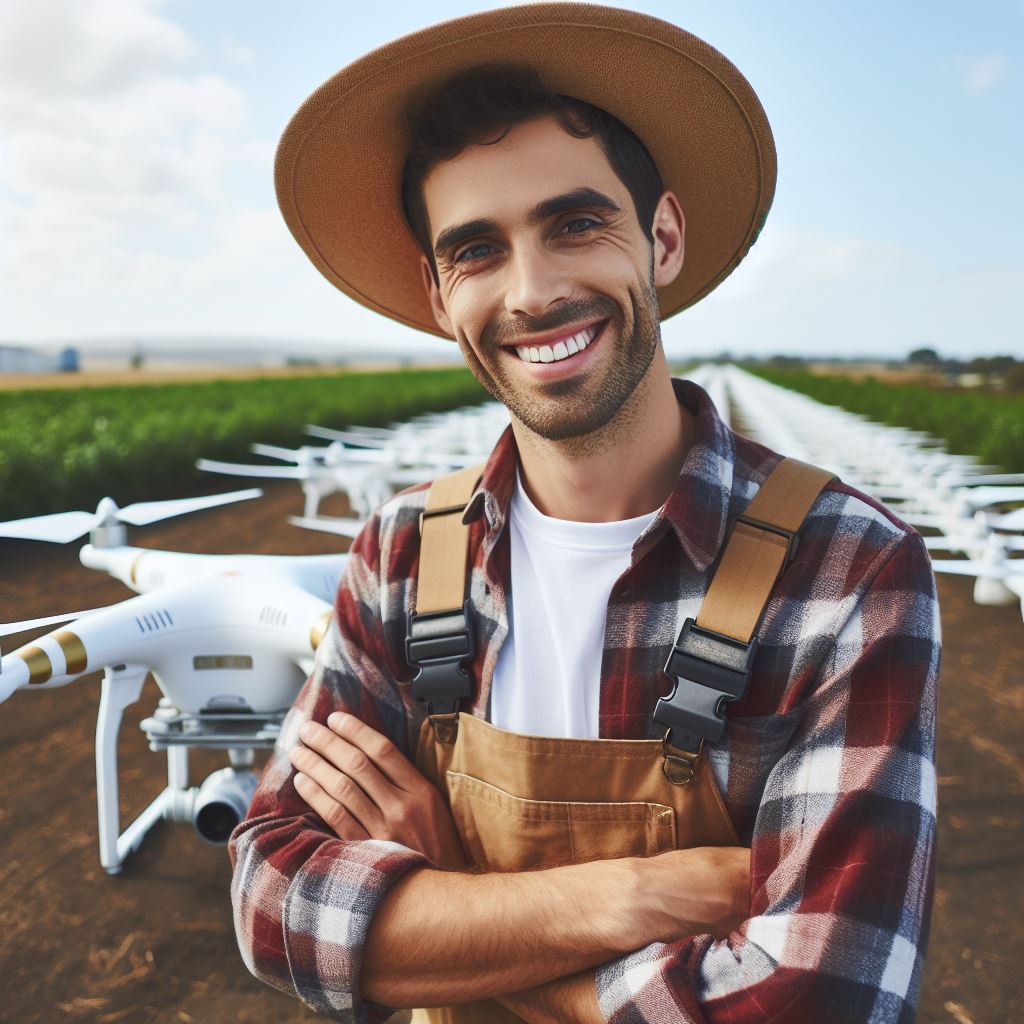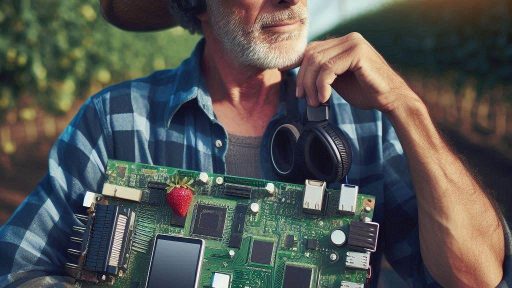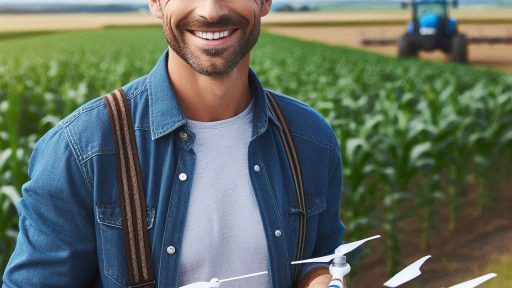Introduction
Agri drones, also known as unmanned aerial vehicles (UAVs) or remotely piloted aircraft systems (RPAS), represent a technological innovation in agriculture.
These drones are equipped with various sensors, cameras, and other imaging devices, allowing them to collect a wide range of data related to agricultural activities.
Their importance in modern agriculture cannot be overstated.
Agri drones provide farmers and agricultural professionals with valuable real-time information about crop health, soil conditions, pest infestations, and irrigation needs.
By flying over fields and capturing high-resolution images, drones enable precise monitoring and analysis of agricultural landscapes.
This data-driven approach enables farmers to make informed decisions regarding planting, fertilization, pest control, and irrigation management, ultimately leading to increased crop yields, improved efficiency, and reduced environmental impact.
In summary, agri drones play a vital role in revolutionizing modern agriculture by offering advanced capabilities for data collection, analysis, and decision-making.
Read: Water-Saving Tech in Agriculture: Startups to Watch
Benefits of Agri Drones
In recent years, the use of agricultural drones has gone beyond just surveillance.
These unmanned aerial vehicles (UAVs) are revolutionizing the farming industry by providing numerous benefits that were not possible before.
Let’s explore some of the advantages of using agri drones.
A. Improving surveillance and monitoring of crops
One of the primary benefits of agri drones is their ability to enhance surveillance and monitoring of crops.
By flying over fields, these drones can quickly detect diseases and pests, allowing farmers to take timely action.
Early detection leads to more effective treatment, preventing greater damage and loss of crops.
Additionally, drones can monitor the health and growth of crops, providing valuable insights for farmers.
B. Precision agriculture and data collection
Agri drones are essential tools for precision agriculture, as they enable farmers to collect data with high precision and accuracy.
Equipped with advanced cameras and sensors, these drones capture high-resolution aerial imagery.
This imagery can then be analyzed in detail, helping farmers identify specific areas of concern, such as nutrient deficiencies, soil erosion, or water stress.
The collected data also plays a crucial role in decision-making processes, allowing farmers to make informed choices regarding irrigation, fertilization, and crop management.
C. Enhancing crop spraying and fertilization
Another significant benefit of using agri drones is their ability to improve crop spraying and fertilization practices.
Drones equipped with specialized equipment can precisely apply chemicals and fertilizers, ensuring accurate and uniform coverage.
This precision minimizes wastage and reduces the environmental impact associated with excessive use of chemicals.
By targeting specific areas or individual plants, farmers can optimize resource usage, saving both money and resources.
Furthermore, agri drones can reach areas that are difficult to access manually, such as steep slopes or dense vegetation.
This accessibility allows for more comprehensive and efficient coverage, ultimately improving overall crop health and yield.
In fact, agri drones offer significant benefits to the agricultural industry.
Their ability to improve surveillance and monitoring of crops, enable precision agriculture and data collection, and enhance crop spraying and fertilization practices makes them invaluable tools for modern farmers.
As technology continues to advance, we can expect even more innovative applications and advantages from agri drones in the future.
Read: Crop Monitoring Tech: Agri-Tech’s New Tools
Beyond Surveillance: Innovative Uses of Agri Drones
Agri drones, once primarily used for surveillance purposes, are now being employed in various innovative ways to enhance agricultural practices.
Beyond their initial role, they are proving to be valuable tools for addressing important agricultural challenges.
A. Pollination assistance
One significant area where agri drones are being utilized is pollination assistance.
With the decline in natural pollinators like bees, drones are being considered as potential substitutes to ensure successful crop pollination.
The use of drones as pollination agents involves equipping them with pollen and directing them to specific flowers to facilitate cross-pollination.
This innovative approach helps address the scarcity of natural pollinators and provides agriculturalists with an alternative solution.
B. Crop monitoring and mapping
Another notable application of agri drones is crop monitoring and mapping.
Drones equipped with high-resolution cameras and sensors enable farmers to analyze field conditions in real-time.
Transform Your Agribusiness
Unlock your farm's potential with expert advice tailored to your needs. Get actionable steps that drive real results.
Get StartedThese drones gather data regarding crop health, growth patterns, and pest infestations.
By generating detailed maps of their fields, farmers can make informed decisions about resource allocation, such as fertilizers, pesticides, and irrigation, leading to more efficient and targeted agricultural practices.
C. Irrigation management
Effective irrigation management is crucial for optimal crop growth and water conservation.
Agri drones are transforming this aspect by offering valuable insights and assisting with irrigation schedules.
By monitoring soil moisture levels from above, drones provide real-time data about the water requirements of crops.
This information enables farmers to optimize their irrigation schedules and prevent both over- and under-irrigation, which can significantly impact crop yields.
Moreover, these drones aid in water usage optimization by identifying areas prone to water wastage or leakage.
By detecting such issues promptly, farmers can take immediate action, conserve water, and ensure its efficient distribution.
In essence, the applications of agri drones extend far beyond just surveillance.
They are providing innovative solutions to agricultural challenges.
Through pollination assistance, crop monitoring and mapping, and irrigation management, these drones are revolutionizing traditional farming practices and paving the way for more sustainable and efficient agriculture.
Read: Innovations in Livestock Comfort Control

Challenges and Limitations of Agri Drones
Agri drones have gained popularity in the agriculture industry due to their ability to go beyond surveillance and offer various benefits.
However, along with their advantages, these drones also come with certain challenges and limitations that need to be addressed.
A. Cost and accessibility
One of the primary challenges faced by farmers when considering agri drones is the cost and accessibility aspect.
These drones require a considerable initial investment and ongoing maintenance expenses.
The high cost may pose a barrier for small-scale farmers who may not have enough resources to afford them.
This limitation can hinder the adoption of agri drones, preventing farmers from benefiting from the technology.
B. Regulatory and legal issues
Another significant challenge is the regulatory and legal issues surrounding agri drone usage.
Compliance with aviation and privacy laws is crucial to ensure the safe and ethical operation of the drones.
Meeting these requirements can be a complex task, as laws are continually evolving, making it challenging for farmers to stay updated and comply with the regulations.
Additionally, overcoming restrictions and obtaining the necessary licenses for operating drones can be time-consuming and burdensome.
C. Technical limitations
The technical limitations of agri drones also pose challenges for their widespread use.
Battery life is a critical limitation as it determines the flight time of the drones.
Most agri drones have limited battery capacity, which restricts their ability to cover large areas in a single flight.
This limitation can impact efficiency and productivity, especially when monitoring vast agricultural fields.
Farmers may need to invest in additional batteries or recharge frequently, which can be cumbersome and time-consuming.
Moreover, weather conditions and environmental factors can significantly affect agri drone operations.
Adverse weather conditions such as strong winds, rain, or extreme temperatures can make it unsafe or impossible for drones to operate.
Environmental factors such as dense foliage, uneven terrain, or limited visibility due to dust or fog can also hinder drone performance.
These limitations can limit the reliability and effectiveness of agri drones, making them less practical in certain agricultural settings.
In general, while agri drones offer immense potential in revolutionizing the agriculture industry, they also face challenges and limitations that need to be addressed.
The cost and accessibility aspect, the regulatory and legal issues, as well as the technical limitations surrounding battery life and weather conditions, pose hurdles for their widespread adoption.
Overcoming these challenges will require collaboration between stakeholders, including farmers, drone manufacturers, regulatory agencies, and policymakers, to create solutions that make agri drones more accessible, cost-effective, and efficient.
Once these challenges are overcome, agri drones can play a crucial role in enhancing the productivity, sustainability, and profitability of the agriculture sector.
Read: Data-Driven Livestock Nutrition Plans
Conclusion
Advancements in agri drone technology have the potential to revolutionize agriculture and farming practices.
These drones, which go beyond just surveillance, can greatly enhance efficiency and productivity in the industry.
Through the use of AI, sensors, and precision technology, agri drones can improve crop monitoring, maintenance, and irrigation, leading to higher yields and reduced waste.
Furthermore, these drones can provide valuable insights through data collection and analysis, helping farmers make informed decisions and optimize their operations.
While there are challenges to overcome, such as regulations and cost, the benefits of agri drones are undeniable.
They offer a more sustainable and environmentally friendly approach to agriculture, reducing the need for harmful chemicals and excessive water usage.
In closing, agri drones have the potential to transform the future of agriculture, enabling farmers to achieve better results while conserving resources.
The increased use of these drones can lead to a more efficient and sustainable industry, ensuring food security for the growing global population.




